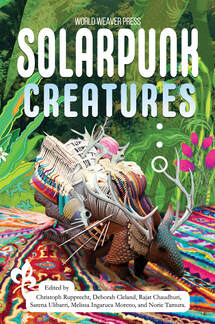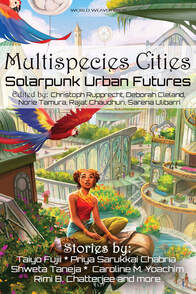 Guest Blog by Rimi B Chatterjee Hi, I’m Rimi B. Chatterjee, and I’m a screenwriter, storyteller and academic based in Kolkata, India. Since 2005 I’ve been working on the Antisense Universe, a storyworld focused on climate action and civilisational redesign. The story arc is vast and spans from the Nineties to the twenty seventh century, covering the entire globe and near space, eventually also involving Venus. This story, Hopdog, is set circa 2080 in the Tarim Basin, after an apocalypse has destroyed the framework of our current civilisation and corporate power-structures are running a kind of post-feudal racket whereby they enslave everyone and party in the ruins. However, a group of Survivors who were thrown away in the desert have built a new kind of civlisation in their underground settlement called a survivarium, and they are now populating the survivarium with people and animals they are rescuing from the corporate slave camps. Peaches, the dog in my story, is one such rescue, along with the woman Peaches and her fellow dog-slaves were supposed to kill. That woman, who is called Queen Bitch in the story, is one of the major characters in the Antisense Universe, but I won’t tell you who she is to as to avoid spoilers. The first survivarium is called Zigsa’s Nest, because the philosophy of Antisense and its ethical system, karma, are invented by Zigsa, a teenage Tibetan who escapes from a test-to-destruction lab in Lop Nur and treks through the desert to the Flaming Mountains. I described her journey in ‘Arfabad’, which came out in Multispecies Cities: ‘Hopdog’ is kind of a sequel to ‘Arfabad’.  Zigsa is rather unusual: she has a mission. She begins calling the Survivors to her, at first through their dreams, and later through the Karma Sutra, a manual of how to build a survivarium. The survivariums exist to protect and nurture the ten treasures: people, animals, plants, soil, air, water, light, love, knowledge and karma. Zigsa and her friends create a network of underground activists called rootkittens who inflitrate the service territories to recruit and rescue new Survivors, so that they can go out into the wilderness and use the Karma Sutra to build survivariums of their own. The point of Antisense is to find a new way to organise work, reward happy-making actions and keep people safe, healthy and joyful. The Survivors do this by replacing the law and money of hanyo town with karma. The principle behind karma is this: it is a way of saying thank you. When the Survivors first gathered in their cave, many were sick of mind and body. If others had not fed, healed, comforted and warmed them, they would not have survived. Because their memories were full of holes, they used coloured threads they stole from a corporate shipment to keep track of everyone’s happy-making activities. These threads were in ten colours, each representing a particular kind of happy-making activity: healing, feeding, building things, tending the plants they begin to cultivate under stolen whitelights, scooping out new caves to accommodate newcomers. This tenfold division was because the rules and goals of breaking rock are a bit different than those of conversation or healing wounds. More details about this system can be found on my site antisenseuniverse.org. Once the Survivors have established the basis of their civilisation, and a group of miners among them have dug down and hollowed out the space for the survivarium, the Survivors began scouting for the ten treasures to place in their new home. They creep into the corporate cities, steal the animals out of zoos and the trees and plants from under biodomes. Because the story is told from Peaches’ point of view, I could not introduce you to Zohra, the six-foot-tall trucker who engineers Peaches’s rescue in the sixteen-wheeler truck used to transport the dogs to the fighting arena. But don’t worry, Zohra’s story will be told elsewhere. The core of Antisense is this: what would a truly good world look like, and how would it work? Who would live in it, and what would their day-to-day routine of work and play be? How would children grow, and how would people’s lives change when they’re old? What would they eat, and how would they dispose of waste? What would their systems for righting wrongs look like, and how would they treat victims and wrongdoers? How will they treat animals and nature? All of these questions are answered in the Antisense Universe, notably in the Karma Sutra which is 80 per cent written. In the coming days, I hope to write and publish more stories that will showcase this world, and eventually, make a series of animation films that will cover the whole story arc. Rimi B. Chatterjee is a screenwriter, novelist and academic based in Kolkata, India. She is currently developing the Antisense Universe, a storyworld focused on civilisational redesign and climate action, in which this story is also set. Eventually she hopes to produce a series of animation feature films set in this world.
0 Comments
Your comment will be posted after it is approved.
Leave a Reply. |
World Weaver PressPublishing fantasy, paranormal, and science fiction. Archives
February 2024
|
- Home
-
Books
-
All Books
>
- Beyond the Glass Slipper
- Bite Somebody
- Bite Somebody Else
- Black Pearl Dreaming
- Cassandra Complex
- Causality Loop
- Clockwork, Curses, and Coal
- Continuum
- Corvidae
- Cursed: Wickedly Fun Stories
- Dream Eater
- Equus
- Fae
- Falling of the Moon
- Far Orbit
- Far Orbit Apogee
- Fractured Days
- Frozen Fairy Tales
- Glass and Gardens: Solarpunk Summers
- Glass and Gardens: Solarpunk Winters
- Grandmother Paradox
- Grimm, Grit, and Gasoline
- Haunted Housewives
- Heir to the Lamp
- He Sees You When He's Creepin': Tales of Krampus
- Into the Moonless Night
- Jack Jetstark's Intergalactic Freakshow
- King of Ash and Bones (ebook)
- Krampusnacht
- Last Dream of Her Mortal Soul
- Meddlers of Moonshine
- Mothers of Enchantment
- Mrs Claus
- Multispecies Cities
- Murder in the Generative Kitchen
- Recognize Fascism
- Scarecrow
- Sirens
- Shards of History
- Shattered Fates
- Skull and Pestle
- Solarpunk (Translation)
- Solarpunk Creatures
- Solomon's Bell
- SonofaWitch!
- Speculative Story Bites
- Trenchcoats, Towers, and Trolls
- Weredog Whisperer
- Wolves and Witches
- Anthologies and Collections
- Novels
- Novellas
- Fairy Tale
- Fantasy
- Romance
- Science Fiction
- Urban/Contemporary Fantasy
- Young Adult SFF
-
All Books
>
- Blog
- About
- Contact
- Press / Publicity
- Newsletter Signup
- Privacy Policy
- Store

 RSS Feed
RSS Feed